The History Of Nissan President

The Nissan President is a Japanese luxury limousine introduced by Nissan in the 1960s and sold only in the Japanese market. In the early 1990s, it was introduced in the Singapore market, and it saw limited sales. The President is used mainly as a chauffeur car for government and corporate officials, and its main competitor in the Japanese market is the Toyota Century.
The first generation of the Nissan President, designated 150, debuted in 1965, replacing the Cedric Special as Nissan's top-of-the-range model. Available with either the 4.0litre Y40 V8 engine, developed specially for that model, or a 3.0litre H30 Straight-6, this model served as the official car of the Japanese Prime Minister Eisaku Sato.
The Nissan President 150 was replaced by a new 250 generation in 1973. The V8 engine had its displacement increased to 4.4litre and was now designated Y44E, and a 3.0litre version was still available. This chassis was mainly the same with a new front face grille. In 1977 the Sovereign trim was added. The President (H150) was introduced in October 1965 as a replacement for the Cedric Special. It had a choice of H30 six-cylinder and Y40 V8 engines and was very lavishly appointed for its time. The second generation (H250) was introduced in 1973 with the Y44 engine (later receiving fuel injection), and would continue until 1990.
The 250 underwent a major redesign in 1982, notable design changes are the replacement of the round headlights with square versions. Larger fuel tank, and suspension improvements. In 1985, the Sovereign VIP trim was added. Production of the 250 series continued until 1990.
In October 1989 a new Nissan President, designated JHG50, debuted during the Tokyo Motor Show, with sales beginning a year later. Concurrently, a short-wheelbase version of the chassis debuted in the USA as Infiniti Q45 or Nissan Q45 in Japan, with a different front and rear end. Both shared the new 4.5litre VH45DE V8 engine. In 1993, a short-wheelbase version similar to the Infiniti joined the lineup, badged as President JS. At the same time, Nissan's special vehicles subsidiary Autech developed a Royal Limousine model with split passenger compartment.
An interesting feature also debuted in 1993 — an airbag for the left-hand side (curbside) rear seat passenger. In 1994, along with a minor facelift, Nissan revived the Sovereign trim level (previously available for 250 Presidents) for the long-wheelbase model. Another minor facelift occurred in 1998 (designated PHG50). At the same time, the previous Infiniti Q45 was replaced by a model based on a smaller (yet still large) Nissan Cima, which was also fitted with the rear passenger airbag option in Japan. The PHG50 continued in production till 2002 with the arrival of the new F50 chassis.
The third generation was introduced in 1990. A shortened version is sold as the Infiniti Q45 in markets outside Japan. The theme was continued with the fourth (2003). The JG50 President continued until 2002, and it was replaced in 2003 by a new PGF50 model, based on the F50 Nissan Cima, which debuted in 2001, being also powered by the same 4.5litre VK45DE V8 engine. Two versions are available, both badged Sovereign, with either 5-passenger or 4-passenger seating configuration.
The 4-passenger version is considerably more expensive and features lavish equipment, including a Bose sound system and a host of other electronic devices controlled from a panel in the rear central armrest, as well as a "relaxing seat" — a feature allowing the left front passenger seat to be slid far forward, allowing the passenger in the rear to stretch his or her legs. To compete with other luxury marques in Japan, the Nissan President incorporated trim made outside Japan (such as using Connolly leather)[citation needed].
From Wikipedia, the free encyclopedia
More About Nissan President
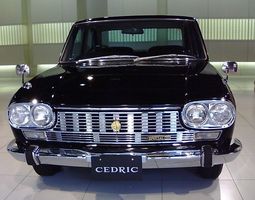

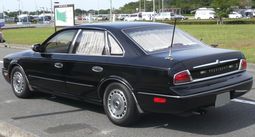
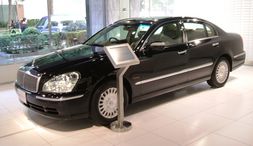
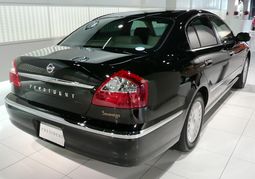
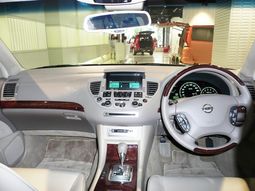
|